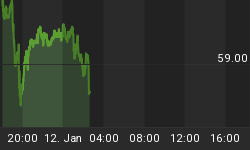Originally published by Institutional Advisors on October 4, 2006.
This old saying sums it up. One day there seems to be endless liquidity and the next day - none. Of course, the transition involves more than one day and it is usually accomplished as, one by one, various traders discover a sudden loss of liquidity whereby the bids for the hot games disappear, as does the credit needed to carry a losing position.
The key to the transition has been simple - prices stop going up. More elaborate explanations have been provided by von Mises, who roughly observed that for a boom to peak the commercial banks don't need to call the loans, they just have to become a little concerned and stop making them.
The "Dearth Of Credit" by von Mises is attached.
Of course, the sudden loss of liquidity that marks the end of a boom and its effect on the credit markets has been on the financial scene for a very long time. For example, during just such a crisis in 1560 Sir Thomas Gresham wrote that credit conditions in the world's financial centre (Antwerp) were so tight that credit was not available, "even on double collateral".
The term for readily available credit - "easy" - is Dutch and so is its opposite, "diseased" credit conditions.
The transition to a dearth of credit seems eligible now. For this, the yield curve should have inverted and be working its way to steepening (√) and credit spreads, after being remarkably narrow, should be turning to widening (not quite). Preceding this, actual or momentum highs should have been set by the main items in the speculative play.
Of these, housing merits a (√), as do base metal and energy commodities. The general stock market, including the Nasdaq, set a momentum peak in the Spring.
Although credit conditions may seem benign, there is no reason to extrapolate complacency into the future.
The following charts can provide critical perspective - particularly with the observation made by the WSJ on August 17 that some of the borrowing was used "to repurchase more shares and to make higher quarterly and special-dividend payouts".
Then on September 23, The Economist wrote "Egging borrowers on are bankers, who sometimes admit to lending amounts, as a multiple of underlying cash flows, that are against their better judgement. This, they say, is partly because the competition to provide credit is so fierce."
NON-FINANCIAL CORPORATE BORROWING
The noteworthy feature is that this measure of borrowing peaked in the Spring at a spike high close to the peak high in 1999.
The next chart shows just how extraordinary stock buy-back programs have been.

These charts provide an interesting overview on a borrowing mania. The record is indelible, as in getting to this condition cannot be erased by wishful thinking. In past examples, the condition has been unsustainable and, once again, the fallout will be significant.
The Economist article included "More febrile [feverish] still has been the popularity of new fangled derivatives, with difficult names."
This reminds of exasperation recorded by an injured player as the South Sea Bubble collapsed in the Fall of 1720.
"The poor English nation run a madding after new inventions, whims, and projects [promotions] ... They can ruin men silently, undermine and impoverish, fiddle them out of their money by strange, unheard of engines of interest, discount, transfers, debentures, shares, projects, and the Devil and all of figures and hard names."
The key series to watch now is the treasury curve for steepening and gold's price relative to commodities turning up.
DEARTH OF CREDIT
The full understanding of credit and its cycles has been provided by the Austrian School of Economics. Its leading exponent has been Ludwig von Mises and some of his comments bear witness to today's one-way excesses. It is imperative to have an understanding of credit that works in both financial and tangible asset booms.
"An increase in the quantity of money or fiduciary media is an indispensable condition of the emergence of a boom. The recurrence of boom periods, followed by periods of depression, is the unavoidable outcome of repeated attempts to lower the gross market rate of interest by means of credit expansion. There is no means of avoiding the final collapse of a boom brought about by credit expansion. The alternative is only whether the crisis should come sooner as a result of voluntary abandonment of further credit expansion, or later as a final and total catastrophe of the currency system involved.
The breakdown appears as soon as the banks become frightened by the accelerated pace of the boom and begin to abstain from further credit expansion. The change in the banks' conduct does not create the crisis. It merely makes visible the havoc spread by the faults which business has committed in the boom period.
The dearth of credit which marks the crisis is caused not by contraction but by the abstention from further credit expansion. It hurts all enterprises - not only those which are doomed at any rate, but no less those whose business is sound and could flourish if appropriate credit were available. As the outstanding debts are not paid back, the banks lack the means to grant credits even to the most solid firms. The crisis becomes general and forces all branches of business and all firms to restrict their activities. But there is no means of avoiding these consequences of the preceding boom.
Prices of the factors of production - both material and human - have reached an excessive height in the boom period. They must come down before business can become profitable again. The recovery and return to "normalcy" can only begin when prices and wage rates are so low that a sufficient number of people assume that they will not drop still more."
The Austrians did not distinguish between financial and tangible asset booms, nor provide any examples or a forecasting model.
















